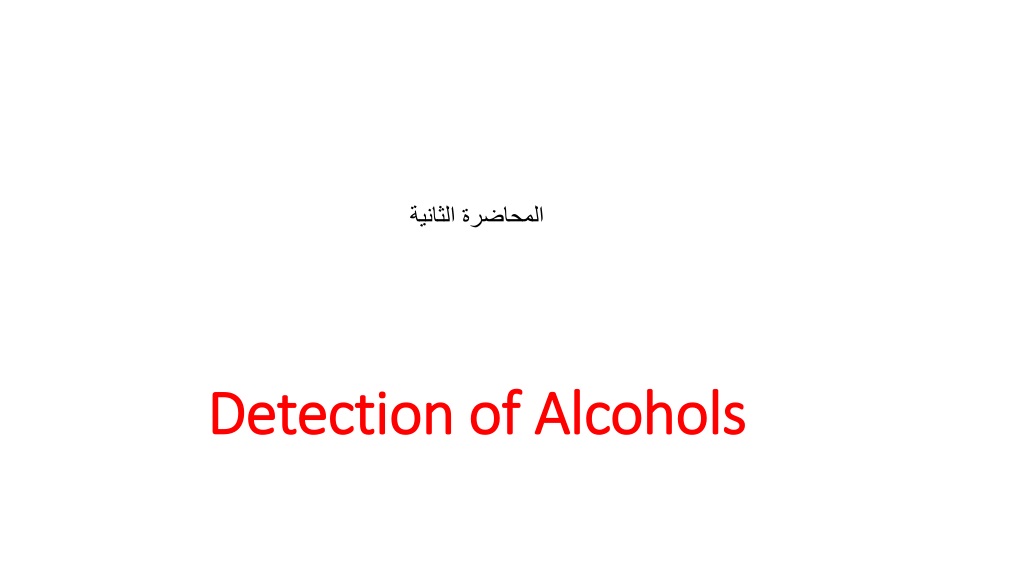

0 likes | 45 Views
The Jones test utilizes chromium trioxide and sulfuric acid to distinguish primary and secondary alcohols from tertiary alcohols. Primary alcohols are converted to aldehydes or carboxylic acids, while secondary alcohols to ketones. The Lucas test uses anhydrous zinc chloride in hydrochloric acid to differentiate between primary, secondary, and tertiary alcohols based on their reactivity. Tertiary alcohols react fastest, followed by secondary and then primary alcohols. Additionally, the ceric ammonium nitrate test can also indicate the presence of alcohols. Caution is advised when handling toxic chromium compounds.

E N D
ةيناثلا ةرضاحملا Detection of Alcohols Detection of Alcohols
• Detection of Alcohols • The Jones test utilizes chromium trioxide in the presence of sulfuric acid to act as a powerful oxidizing agent. In the presence of the Jones' reagent, a primary alcohol is first converted into an aldehyde and then into a carboxylic acid, while a secondary alcohol will be oxidized into a ketone. • by CrO3 Shows positive test for: 1oand 2oalcohols while 3o alcohol show negative test • A primary alcohol is oxidized to an aldehyde or all the way to a carboxylic acid, while a secondary alcohol to a ketone. The mechanism begins with the reaction of CrO3with acid (often H2SO4) to form chromic acid or dichromic acid in more concentrated solutions. • Primary alcohols can be oxidized to form aldehydes and carboxylic acids; secondary alcohols can be oxidized to give ketones. Tertiary alcohols, in contrast, cannot be oxidized without breaking the molecule's C–C bonds.
• The preparation of the Jones reagent. • Dissolve chromium trioxide (25 g, 0.25 mol) in water (75 mL) in a 500 mL beaker and add concentrated sulfuric acid (25 mL) slowly with careful stirring and cooling in an ice-water bath. Keep the temperature of the solution between 0 and 5˚C. The concentration of the solution prepared by this procedure is 2.5 M. • Chromium compounds (especially Cr(VI)) are highly toxic. One must take necessary caution when handling and disposing these compounds. • Procedure Put the unknown in in a test tube and add small drop of Jones reagent (chronic acid in sulfuric acid). A positive test is marked by the formation of a green color to blue color .The Jones reagent will already be prepared for you.
Lucas test for alcohols • The Lucas test in alcohols is a test to differentiate between primary, secondary, and tertiary alcohols. It is based on the difference in reactivity of the three classes of alcohols with hydrogen halides via an SN1 reaction: • ROH + HCl +ZnCl2→ RCl + H2O. "Lucas' reagent" is a solution of anhydrous zinc chloride in concentrated hydrochloric acid. This solution is used to classify alcohols of low molecular weight. The reaction is a substitution in which the chloride replaces a hydroxyl group. A positive test is indicated by a change from clear and colourless to turbid, signalling formation of a chloroalkane. Also, the best results for this test are observed in tertiary alcohols, as they form the respective alkyl halides fastest due to higher stability of the intermediate tertiary carbocation. •
The solution remains colourless unless it is subjected to heat. The solution forms an oily layer when heated. Example: 1-Pentanol. Primary Alcohol The solution turns turbid and forms an oily layer in three to five minutes (varies based on the solubility). Example: 2-Pentanol. Secondary Alcohol The solution turns turbid and forms an oily layer immediately. Example: 2-methyl-2-butanol. Tertiary Alcohol
• Primary, Secondary, and Tertiary alcohols react with the lucas reagent to form the chloroalkane at different rates. Tertiary alcohols react the fastest due to the fact the organic chloride has relatively low solubility in the aqueous mixture. Lucas Test for Primary, Secondary, and Tertiary Alcohols As discussed earlier, the test can be used to differentiate the reaction speed of the alcohol with the given Lucas reagent. This is done by measuring the time taken for the clear solution to turn turbid. Given in next slide a equation describing the positive Lucas test observations for different types of alcohols.
• Atertiary alcohol reacts almost immediately to form the alkyl halide, which is insoluble and forms an oily layer Asecondary alcohol reacts within 3 min to 5 min.
Aprimary alcohol does not noticeably react with Lucas reagent at room temperature. • Primary, Secondary and Tertiary Alcohols are classified based on their reactivity with the Lucas reagent.
• 3-ceric ammonium nitrate test for alcohols • Dissolve a small amount of the compound in water and then add ceric ammonium nitrate. The change of the solution in to red color indicate the precence of alcohol. •